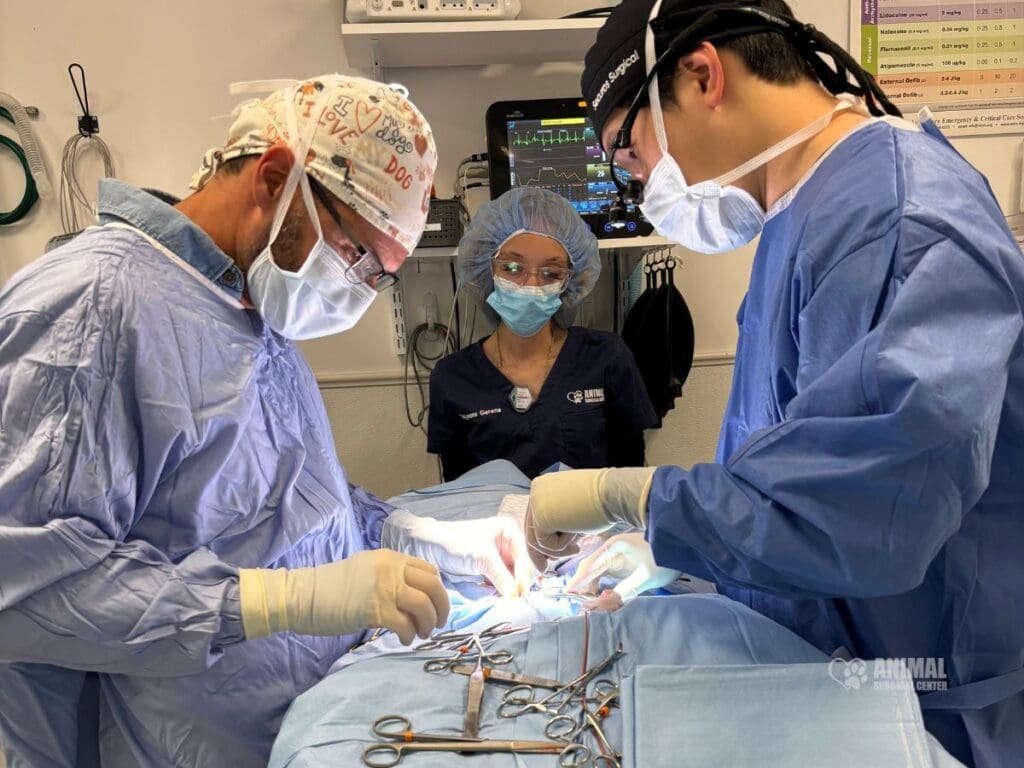Article Release: Issue 6
Release Date: July 24, 2024
Written By: Dr. Tomas Infernuso DVM, DACVS

At Animal Surgical Center (ASC), we pride ourselves on delivering exceptional veterinary care through collaboration, expertise, and dedication. Recently, our team successfully performed a complex surgery on a 20-week-old puppy named Cooper diagnosed with Patent Ductus Arteriosus (PDA). This remarkable achievement would not have been possible without the outstanding efforts of our esteemed colleagues, Dr. Jin and Dr. Infernuso, and the unwavering commitment of our entire staff.
Understanding Patent Ductus Arteriosus (PDA)
Patent Ductus Arteriosus (PDA) is a congenital heart defect that affects both humans and animals. In a developing fetus, the ductus arteriosus is a blood vessel that connects the pulmonary artery to the descending aorta. This vessel allows blood to bypass the lungs, which are not yet in use. Normally, the ductus arteriosus closes shortly after birth as the newborn begins to breathe air, and the lungs take over oxygenating the blood.
However, in some cases, this vessel remains open (patent), leading to PDA. When PDA persists, it can cause an abnormal flow of blood between the aorta and pulmonary artery, resulting in increased blood flow to the lungs. Over time, this can lead to congestive heart failure, pulmonary hypertension, and other serious complications if left untreated.
Common Treatment Approaches for PDA
Treatment for PDA often involves either medical management or surgical intervention, depending on the severity of the condition and the age of the patient. In many cases, especially in young animals, surgical correction is the preferred approach to ensure long-term health and quality of life.
Medical Management for PDA
In mild cases, medications such as nonsteroidal anti-inflammatory drugs (NSAIDs) can be used to encourage the closure of the ductus arteriosus. However, this approach is less commonly successful in animals compared to humans.
Surgical Intervention for PDA
Surgical correction of PDA is the most effective treatment. The procedure involves either ligating (tying off) or closing the ductus arteriosus to prevent abnormal blood flow. This can be achieved through traditional open-heart surgery or minimally invasive techniques such as catheter-based occlusion.
A Case Study: Cooper‘s Journey To Health
Cooper, a lively 20-week-old Pomapoo weighing 3.8 kg (8.4 lb), whose boundless energy and wagging tail never failed to bring smiles to everyone at ASC. Cooper’s journey with us began when his concerned owner noticed he was tiring easily during playtime. His local veterinarian diagnosed him with a heart murmur. After a thorough diagnostic evaluation (an echocardiogram), it was determined that Cooper needed surgery to correct his PDA and ensure a happy, healthy life.

Dr. Jin, Dr. Infernuso, and our highly skilled surgical team collaborated closely to perform the delicate procedure. Their expertise, combined with the exceptional support of our dedicated staff around the clock, ensured a successful outcome for our brave little patient. The surgery involved the precise ligation of an abnormal blood vessel (ductus arteriosus) that bypasses lung circulation. This complex procedure effectively corrected the abnormal blood flow, allowing Cooper to recover and thrive.
The Role of Animal Surgical Center in Achieving Success
This success story highlights the critical role that the Animal Surgical Center plays in delivering outstanding veterinary care. Our team’s ability to collaborate, coupled with the state-of-the-art facilities and unwavering commitment to our patients, is what sets ASC apart. Every member of our staff, from surgeons to support personnel, contributed to the positive outcome of this complex case.
Cooper’s story doesn’t end with the surgery. After a successful procedure, Cooper quickly bounced back, returning to his playful self. We eagerly anticipate seeing Cooper chase after balls, enjoy his favorite squeaky toys, and run without tiring. The joy he will experience will be priceless.
We are proud of the exceptional service we provide and remain dedicated to ensuring the health and well-being of our patients through innovative and compassionate care.

For More Information
The successful surgery on the 4-month-old puppy with PDA is a testament to the expertise and dedication of the team at Animal Surgical Center. By emphasizing collaboration, advanced techniques, and comprehensive care, we continue to make a significant impact on the lives of our patients and their families. For more information about Patent Ductus Arteriosus (PDA), its treatment options, or the veterinary services we offer at Animal Surgical Center (ASC), please contact us or visit our website at www.asc.vet. Together, we can ensure the best possible outcomes for all our furry friends.
Don’t forget to follow us on social media @animalsurgicalcenter for updates and heartwarming stories. Check out our latest reel here for a glimpse of our recent success story.
With Compassion and Care,
The ASC Team
About Us
At Animal Surgical Center, our dedicated team is driven by a profound passion - to save as many animals as possible by providing excellent care and service at a fair price.
